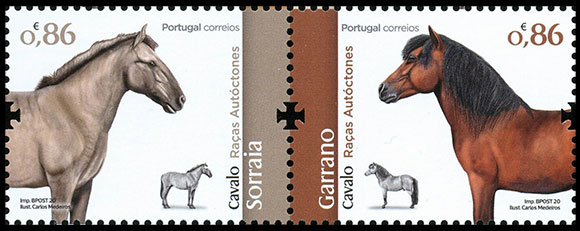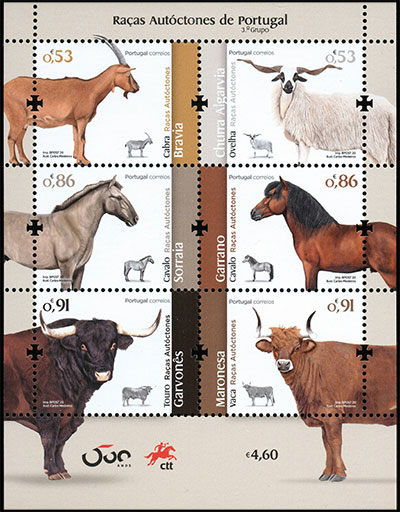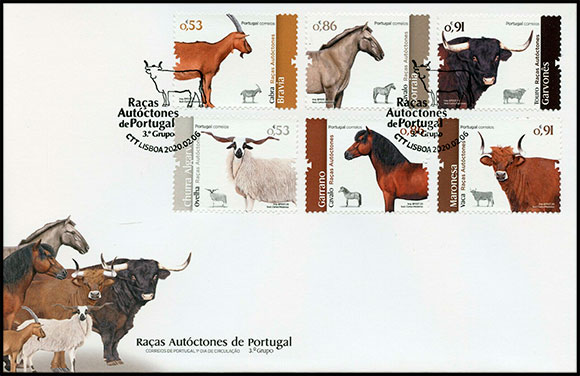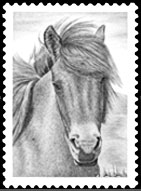
On February 6, 2020, the Portuguese Post issued a series of 6 stamps and a miniature sheet dedicated to local breeds.
A series of stamps dedicated to regional breeds was launched by the Portuguese Post in 2018. It showcases a variety of native Portuguese domestic animals and birds. The 2020 edition is the third in the series and showcases local breeds of horses, cows, sheep and goats. Despite changes in agriculture, the breeds displayed on the stamps still play a role in tourism and recreation within the natural ecosystem.

Among the horses in this issue are the Sorraia and Garrano. In addition the Bravia goat from northern Portugal, the Algarve Churro sheep - wool being extensively used in the production of blankets, the Vaca Maroneza cow from the Serra do Marao region and the Turo Garvones bull from Baixo Alentejo – also endangered. Each breed has its own history and peculiarities of use, sometimes quite unusual. For example, herds of beef cattle have recently been used as a natural remedy against the spread of wildfires and, similarly, herds of goats will create fire breaks by devouring flammable, dry vegetation in inaccessible places.
Sorraia Horse
Sorraia is a rare horse breed found in the Iberian Peninsula in the Sorraia River basin. Sorraia's horses are distinguished by a rare mousy color with a steel sheen, primitive markings, strong legs with clear dark stripes (like those of a zebra) and a characteristic hump-nosed profile. Horses of this breed are undemanding and hardy, well adapted to the harsh living conditions. For centuries, small herds of wild horses have lived on the uncultivated land and salt marshes of the valleys of the Sorraya River. Local farmers occasionally caught horses and used them for agricultural work. It was not until the 1920s that the remaining small herd was discovered and described by the Portuguese zoologist and paleontologist Dr. Ruy d'Andrade as a breed - the Sorraia horse. Despite efforts to conserve this breed, the horses remain critically endangered with a population of only 200. The breed is closely monitored by the state - horses are bred in several stud farms in Portugal and one herd lives in natural conditions on a ‘closed’ reservation in the southwest of the country. The small stature and docile nature of the Sorray horses make them ideal for teaching children to ride, show jumping and dressage.
Garrano horse
Garrano is a pony of Iberian origin that lives in the northwest of Portugal. Ponies live all year round in the mountainous area of the Peneda-Gerês National Park, they endure harmful conditions and are content with pasture.
The Garrano pony is a strong, hardy, easy to train and courageous horse with a calm character. This horse has an unusually confident step, and moves easily, even on rocky ground and through dense thickets. In the past, Garrano ponies were widely used as a beast of burden, they also served the military for transporting goods and as draught horses.
In the 20th century numbers of the breed have greatly decreased due to the predatory attacks of wolves and increased mechanization of agriculture. In recent years, Arabian blood has been mixed with the breed at the initiative of the Portuguese Ministry of Agriculture. As a result, it was possible to ennoble this breed, which has lost some of its primitive traits. Today the population of Garrano ponies is estimated at about 2,000 heads.
Currently, the Garrano pony is used for heavy work in agriculture. The local breed also plays an important role in recreation and tourism. Horses are actively used for horseback riding and equestrian sports. Despite their size, Garranos are very playful horses that often participate in local trotting competitions. Another application of the Garrano pony is in horse therapy.
For the series, designer Carla Caraça Ramos used illustrations by Carlos Medeiros. The stamps and miniature sheet are in the same style as the 2019 and 2018 editions. The Portuguese post also issued a First Day Cover. On the first day of issue, the stamps were cancelled with a special postmark.

Перейти в каталог


